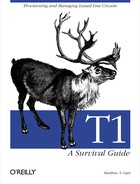The dead govern the living.
As mentioned in Chapter 1, T1 is a time-division multiplexed stream of 24 telephone calls. Each call is carried by a 64-kbps digital stream called a DS0. Several meanings are ascribed to the acronym DS; you may hear any combination of the words data, digital, service, stream, speed, and signal. DS0 is the bottom rung of the T-carrier hierarchy. Higher levels of the hierarchy are built by multiplexing lower levels together. Understanding the T-carrier hierarchy starts with understanding DS0 transmissions.
AT&T’s initial digital leased-line offering was called the Digital Dataphone Service (DDS). DDS was offered at several different speeds, ranging from 2,400 bps to 56 kbps. Service initially topped out at 56 kbps because a portion of the signal is required for timing overhead. DDS circuits formed the Internet backbone in December 1969. Traffic growth eventually overwhelmed the limited-circuit capacity, and the Internet backbone was upgraded to T1 circuits in the late 1980s. Mushrooming traffic led to a further network upgrade to T3 in the early 1990s. Eventually, economics conspired to kill DDS as a standalone service. T1 is not much more expensive, so companies that required more throughput, higher reliability, and guaranteed service levels shifted to T1, while budget-conscious users migrated to cheaper technologies such as DSL.[7]
The telephone network is a circuit-switched network. Each telephone call is assigned to a dedicated path through the network for its duration. Telephone calls require a 64-kbps path through the network. At each hop between switching offices, the trunk lines are divided into 64-kbps channels, which are called DS0s. These individual 64-kbps channels are the building blocks of the telephone network because a DS0 has sufficient capacity for a one-voice telephone call.
To the phone company, 64 kbps means 64,000 bits per second, not the 65,536 bits per second a computer engineer might expect. However, this basic quantity is used by all telephone companies throughout the world. Bundling is different: in the U.S., the T1 standard bundles 24 DS0 channels, plus framing overhead, into a single T1. In Europe, an E1 circuit is composed of 30 DS0 channels, plus framing and signaling overhead. Given the differences in telecommunications between the U.S. and the rest of the world, it should be obvious that since we all use a given standard, there must be something special about 64,000 bits per second.[8]
Transmitting understandable human speech requires using frequencies up to 4,000 kHz. To adequately represent an analog signal in digital format, the analog signal must be sampled at twice the maximum frequency in the signal, a result known as the Nyquist criterion or sampling theorem. To adequately digitize voice, therefore, requires a sampling rate of 8 kHz. Each sample is represented by 8 bits using a technique called Pulse Code Modulation (PCM), where the value of each sample is transmitted as an 8-bit code. In one second, 8,000 samples are transmitted. With a sample size of 8 bits, the resulting data rate is 64,000 bits per second.
DS0s do not impose any higher-level structure on the data stream—they are simply an unframed, raw sequence of bits. The telephone company takes the bits from one location and moves them to another location; to the telephone company’s equipment, it does not matter whether the bits are a voice telephone call or a data circuit, as long as the stream of bits obeys the rules.
[7] Any institution that received even a moderate news feed felt the pressure early. Leased 56k connections running full time at 100% utilization can transfer only slightly more than 575 megabytes in a day.
[8] Technically, the U.S. and the rest of the world do not quite use the same standard. U.S. digital-carrier systems are based on a digital encoding technique called the mu-law, while most of the rest of the world uses a different method called the A-law.
